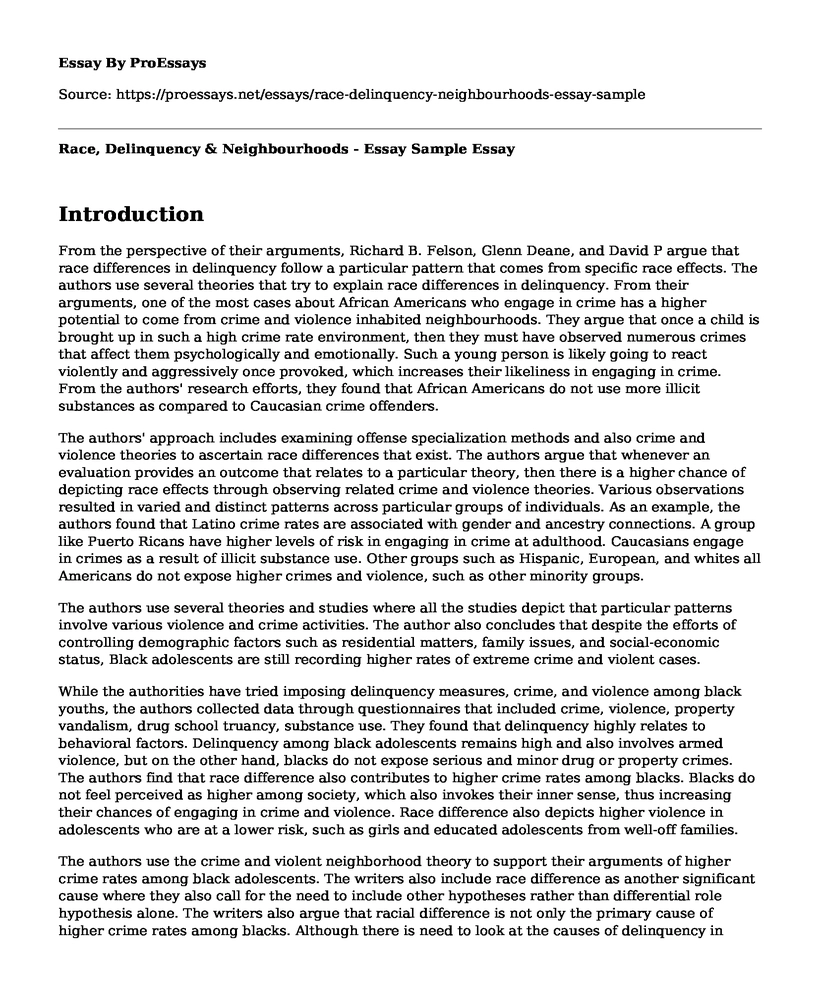Introduction
From the perspective of their arguments, Richard B. Felson, Glenn Deane, and David P argue that race differences in delinquency follow a particular pattern that comes from specific race effects. The authors use several theories that try to explain race differences in delinquency. From their arguments, one of the most cases about African Americans who engage in crime has a higher potential to come from crime and violence inhabited neighbourhoods. They argue that once a child is brought up in such a high crime rate environment, then they must have observed numerous crimes that affect them psychologically and emotionally. Such a young person is likely going to react violently and aggressively once provoked, which increases their likeliness in engaging in crime. From the authors' research efforts, they found that African Americans do not use more illicit substances as compared to Caucasian crime offenders.
The authors' approach includes examining offense specialization methods and also crime and violence theories to ascertain race differences that exist. The authors argue that whenever an evaluation provides an outcome that relates to a particular theory, then there is a higher chance of depicting race effects through observing related crime and violence theories. Various observations resulted in varied and distinct patterns across particular groups of individuals. As an example, the authors found that Latino crime rates are associated with gender and ancestry connections. A group like Puerto Ricans have higher levels of risk in engaging in crime at adulthood. Caucasians engage in crimes as a result of illicit substance use. Other groups such as Hispanic, European, and whites all Americans do not expose higher crimes and violence, such as other minority groups.
The authors use several theories and studies where all the studies depict that particular patterns involve various violence and crime activities. The author also concludes that despite the efforts of controlling demographic factors such as residential matters, family issues, and social-economic status, Black adolescents are still recording higher rates of extreme crime and violent cases.
While the authorities have tried imposing delinquency measures, crime, and violence among black youths, the authors collected data through questionnaires that included crime, violence, property vandalism, drug school truancy, substance use. They found that delinquency highly relates to behavioral factors. Delinquency among black adolescents remains high and also involves armed violence, but on the other hand, blacks do not expose serious and minor drug or property crimes. The authors find that race difference also contributes to higher crime rates among blacks. Blacks do not feel perceived as higher among society, which also invokes their inner sense, thus increasing their chances of engaging in crime and violence. Race difference also depicts higher violence in adolescents who are at a lower risk, such as girls and educated adolescents from well-off families.
The authors use the crime and violent neighborhood theory to support their arguments of higher crime rates among black adolescents. The writers also include race difference as another significant cause where they also call for the need to include other hypotheses rather than differential role hypothesis alone. The writers also argue that racial difference is not only the primary cause of higher crime rates among blacks. Although there is need to look at the causes of delinquency in other aspects of more theories and perspectives, introducing race-specific theories can lead to aggressiveness as they will create havoc, hate, and a perception that defines a particular race as extreme and dangerous. Such a theory might trigger Delinquency violence and crimes. A specific theory might glorify a particular race and undermine the other race, thus creating a significant gap and loophole and loophole for adolescents to collide. In my perspective, the current race-neutral theories work fine considering the current race status in the society.
Cite this page
Race, Delinquency & Neighbourhoods - Essay Sample. (2023, Feb 27). Retrieved from https://proessays.net/essays/race-delinquency-neighbourhoods-essay-sample
If you are the original author of this essay and no longer wish to have it published on the ProEssays website, please click below to request its removal:
- Paper Example on Learning-teaching Approach to Community Development
- The Mongols: Good or Bad?
- The Ideal Communication - Essay Sample
- Causes and Impacts of Divorce in UAE Essay Example
- Community Research Project: Cultural Diversity in Canada Paper Example
- Essay Example on Flowcharting for Visual Clarity: Benefits and Free Templates
- Paper Example on 5 Steps to Improve Managerial Communication







